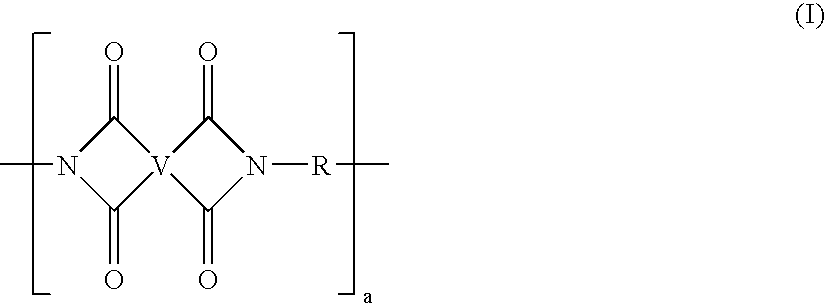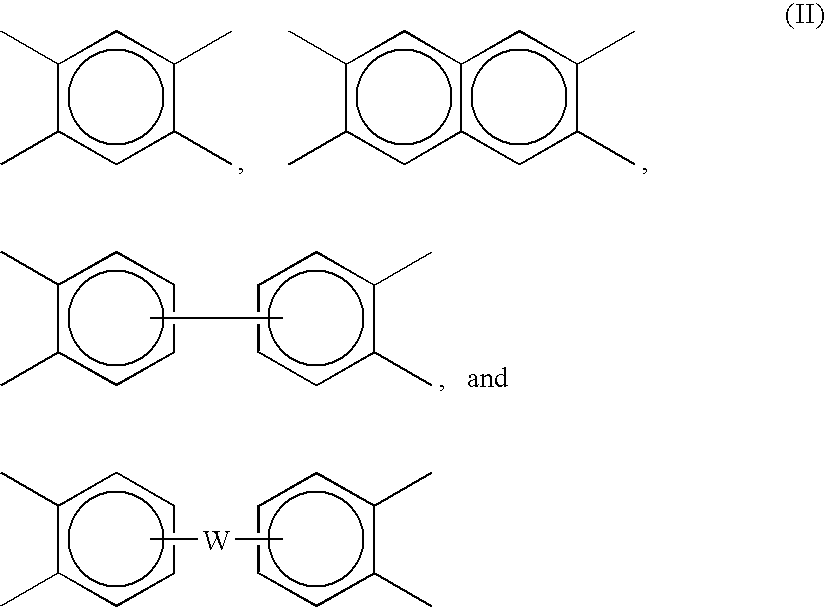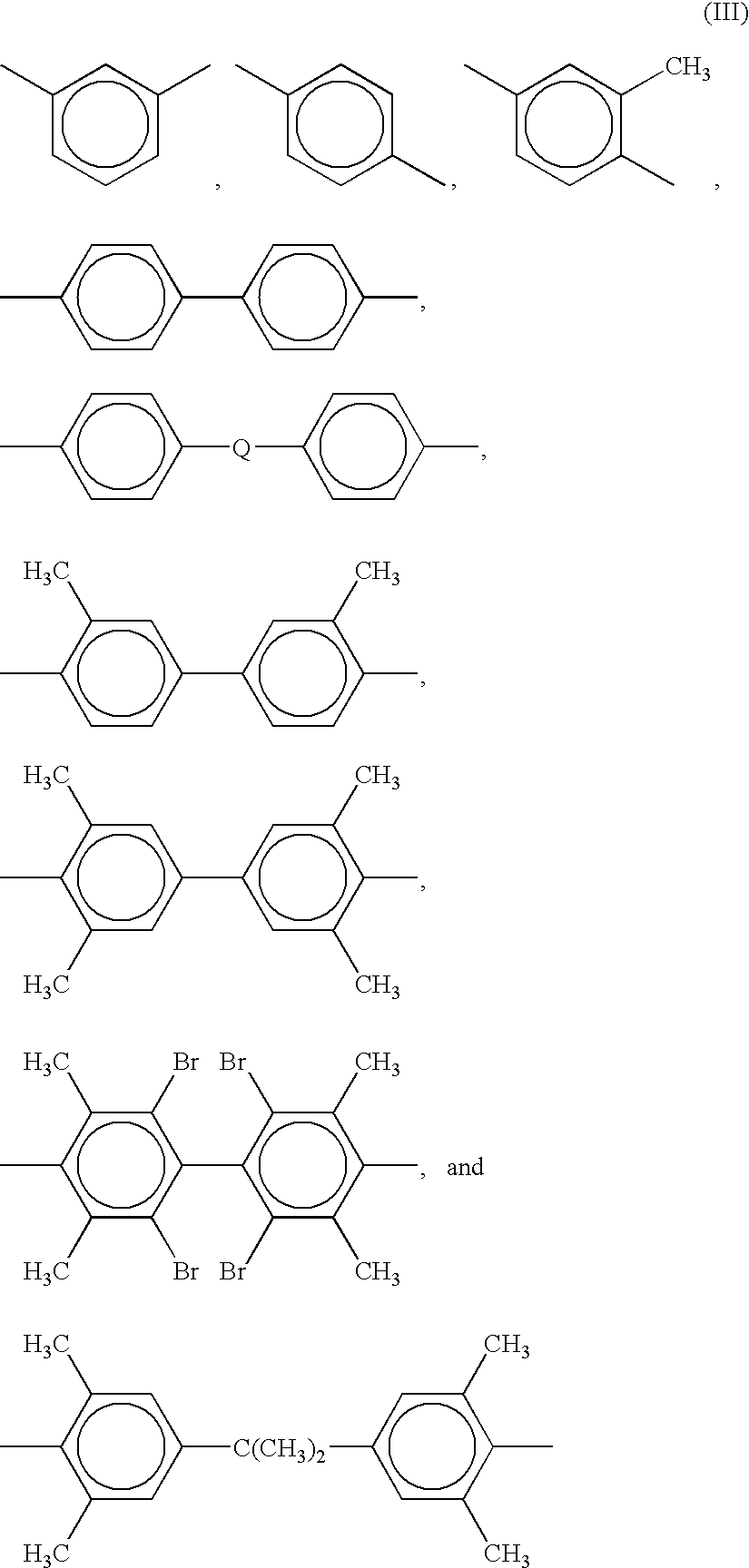Flame resistant thermoplastic composition, articles thereof, and method of making articles
a thermoplastic composition and flame-resistant technology, applied in the direction of coatings, etc., can solve the problems of high gloss articles, frequent impacts on the interior components of trains cars and aircraft, etc., and achieve the effects of reducing gloss, excellent aesthetics, and low gloss
- Summary
- Abstract
- Description
- Claims
- Application Information
AI Technical Summary
Benefits of technology
Problems solved by technology
Method used
Image
Examples
examples 4-6
[0061] The polymer blends described in Table 2 were prepared by first dry blending and then compounding using a vacuum vented 2.5" single screw extruder. The barrel temperatures were 343.degree. C. and the die temperature was 349.degree. C. The screw speed was 100 rpm.
[0062] The resulting pellets were then injection molded into standard ASTM test parts for gloss and impact measurements using a 250 ton molding machine. A barrel temperature of 343.degree. C. and a mold temperature of 121.degree. C. were used for all molding.
[0063] Gloss and biaxial impact measurements were taken as above using ASTM D523 and D3763, respectively. Izod impact testing was carried out according to ASTM D256. Values for unnotched and reverse-notched Izod impact are reported in Table 2.
[0064] Note that comparative example B with the mineral colorant titanium dioxide has good impact strength but high gloss, which is unacceptable for many applications where reflected light is objectionable. The addition of tal...
examples 7-10
[0065] The polymer blends described in Table 3 were prepared by first dry blending and then compounding using a vacuum vented 63.5 mm single screw extruder. The barrel temperatures were 343.degree. C. and the die temperature was 349.degree. C. The screw speed was 100 rpm.
[0066] The resulting pellets were then injection molded into standard ASTM test parts for gloss and impact measurements using a 250 ton molding machine. A barrel temperature of 343.degree. C. and a mold temperature of 121.degree. C. were used for all molding.
[0067] Gloss and biaxial impact measurements were taken as above using ASTM D523 and D3763, respectively. Izod impact testing was carried out according to ASTM D256. Values for unnotched and reverse-notched Izod impact are reported in Table 3. Comparative Example B contains no talc and has high gloss. Examples 7-10 show the effect of increasing talc content on lowering gloss.
[0068] The heat deflection temperature was measured according to ASTM D648, using a pres...
examples 11-14
[0069] The polymer blends described in Table 4 were prepared by first dry blending and then compounding using a vacuum vented 63.5 mm single screw extruder. The barrel temperatures were 343.degree. C. and the die temperature was 349.degree. C. The screw speed was 100 rpm.
[0070] The resulting pellets were injection molded into standard ASTM test parts for gloss and impact measurements using a 250 ton molding machine. A barrel temperature of 343.degree. C. and a mold temperature of 121.degree. C. were used for all molding.
[0071] Gloss and biaxial impact measurements were taken as above using ASTM D523 and D3763, respectively. Izod impact testing was carried out according to ASTM D256. Values for unnotched and reverse-notched Izod impact are reported in Table 4. Examples 11-14 show that variation in the amount of PC and PEI siloxane copolymer all give low gloss blends. Higher levels of polycarbonate give better impact strength (examples 11 vs. 12).
4TABLE 4 11 12 13 14 PEI 80.1 70.4 64....
PUM
| Property | Measurement | Unit |
|---|---|---|
| Fraction | aaaaa | aaaaa |
| Percent by mass | aaaaa | aaaaa |
| Percent by mass | aaaaa | aaaaa |
Abstract
Description
Claims
Application Information
 Login to View More
Login to View More - R&D
- Intellectual Property
- Life Sciences
- Materials
- Tech Scout
- Unparalleled Data Quality
- Higher Quality Content
- 60% Fewer Hallucinations
Browse by: Latest US Patents, China's latest patents, Technical Efficacy Thesaurus, Application Domain, Technology Topic, Popular Technical Reports.
© 2025 PatSnap. All rights reserved.Legal|Privacy policy|Modern Slavery Act Transparency Statement|Sitemap|About US| Contact US: help@patsnap.com



